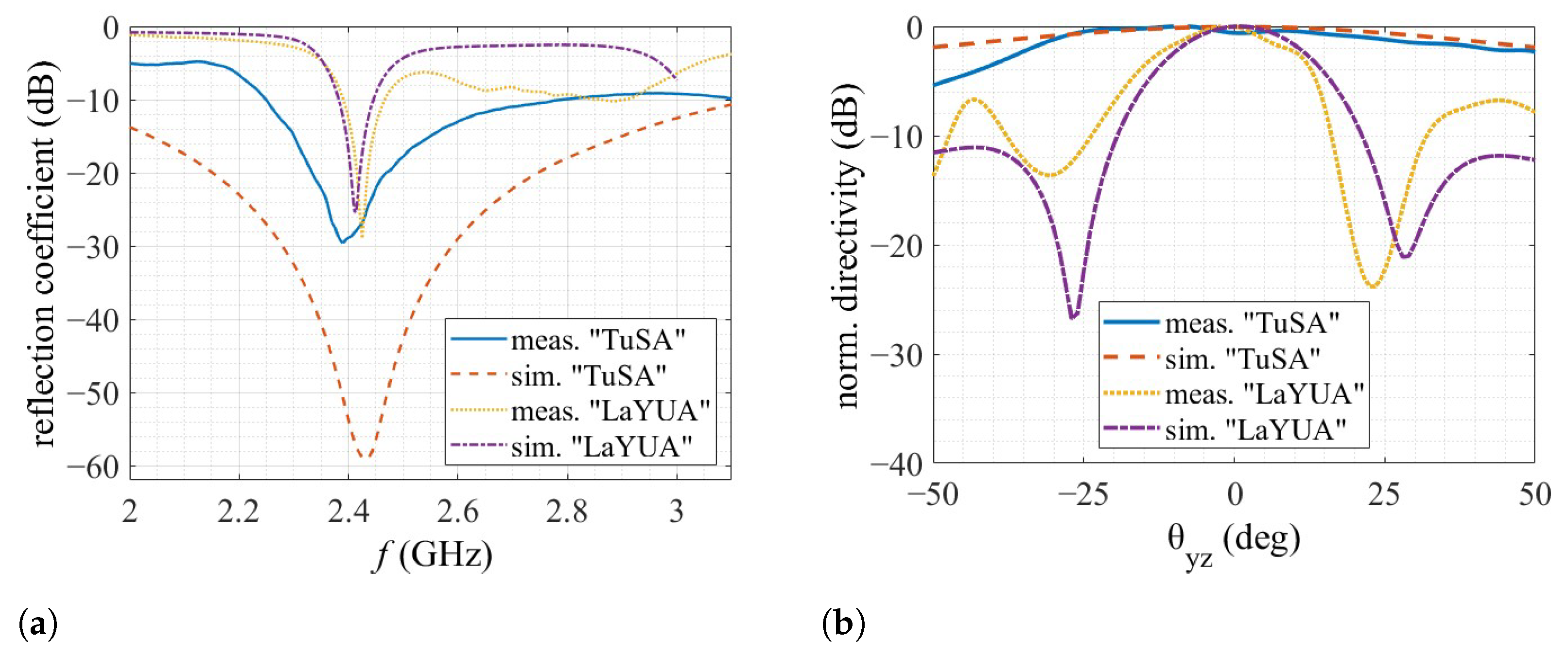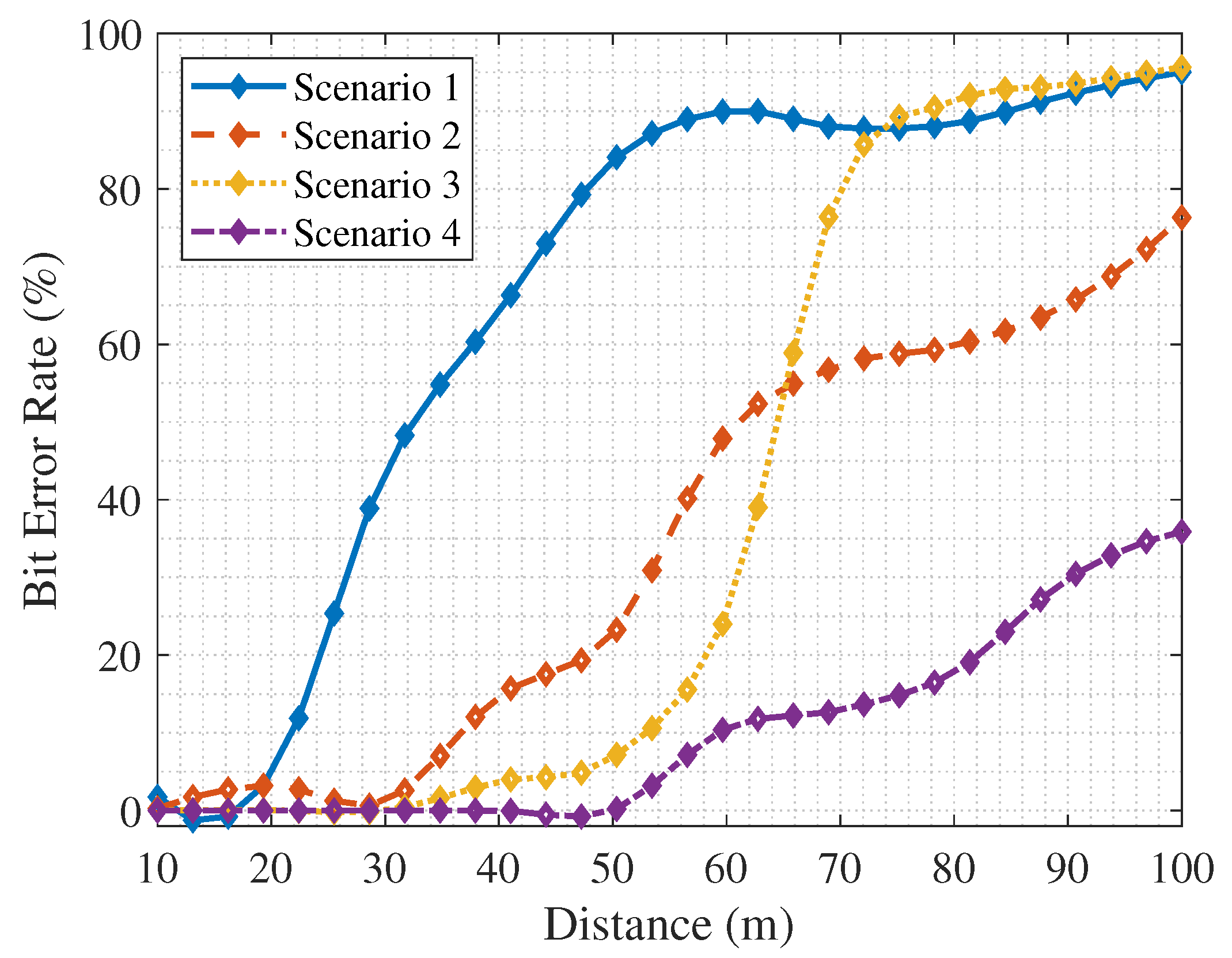Communication System Comparison of IoT Applications Using Custom-Designed Antennas: A Basic Experimental Study †
Abstract
:1. Introduction
2. Methodology
2.1. Equipment System Description
2.2. Antennas Under Test
2.3. Experimental Approach
- Scenario 1
- Commercial dipole antennas: This is the baseline scenario. Both the TxU and RxU are attached with standard commercial dipole antennas.
- Scenario 2
- LaYUA and commercial dipole: This scenario includes the LaYUA, attached to the TxU, and the commercial dipole antenna, attached to the RxU.
- Scenario 3
- Commercial dipole and TuSA: This scenario utilizes the commercial dipole antenna, attached to the TxU, and the TuSA, attached to the RxU.
- Scenario 4
- LaYUA and TuSA: This scenario uses the LaYUA, attached to the TxU, and the TuSA, attached to the RxU.
3. Results
3.1. Antenna Measurements
3.2. System Performance Comparison
3.3. Discussion
4. Conclusions
Author Contributions
Funding
Institutional Review Board Statement
Informed Consent Statement
Data Availability Statement
Conflicts of Interest
Abbreviations
| FR-4 | Flame retardant-4: woven glass-reinforced epoxy resin |
| RF | Radio Frequency |
| TxU | Transmission unit |
| RxU | Reception unit |
| SPI | Serial Peripheral Interface |
| LaYUA | Landstorfer Yagi-Uda Antenna |
| TuSA | Turnstile antenna |
| BER | Bit error rate |
References
- Rappaport, T.S. Wireless Communications: Principles and Practice; Cambridge University Press: Cambridge, UK, 2024. [Google Scholar]
- Hanes, D.; Salgueiro, G.; Grossetete, P.; Barton, R.; Henry, J. IoT Fundamentals: Networking Technologies, Protocols, and Use Cases for the Internet Of Things; Cisco Press: Indianapolis, IN, USA, 2017. [Google Scholar]
- Rathod, N.; Jain, P.; Subramanian, R.; Yawalkar, S.; Sunkenapally, M.; Amrutur, B.; Sundaresan, R. Performance analysis of wireless devices for a campus-wide IoT network. In Proceedings of the 2015 13th International Symposium on Modeling and Optimization in Mobile, Ad Hoc, and Wireless Networks (WiOpt), Mumbai, India, 25–29 May 2015; IEEE: Piscataway, NJ, USA, 2015; pp. 84–89. [Google Scholar]
- Kulkarni, P.; Hakim, Q.O.A.; Lakas, A. Experimental evaluation of a campus-deployed IoT network using LoRa. IEEE Sens. J. 2019, 20, 2803–2811. [Google Scholar] [CrossRef]
- Shen, P.; Qi, Y.; Yu, W.; Fan, J.; Li, F. OTA measurement for IoT wireless device performance evaluation: Challenges and solutions. IEEE Internet Things J. 2018, 6, 1223–1237. [Google Scholar] [CrossRef]
- IEEE Standard for Information Technology—Telecommunications and Information Exchange Between Systems—Local and Metropolitan Area Networks—Specific Requirements—Part 11: Wireless LAN Medium Access Control (MAC) and Physical Layer (PHY) Specifications—Amendment 4: Enhancements for Very High Throughput for Operation in Bands below 6 GHz; IEEE: Piscataway, NJ, USA, 2013; IEEE Standard No. 802.11ac-2013.
- Vakaliuk, T.A.; Andreiev, O.V.; Dubyna, O.F.; Korenivska, O.L.; Andreieva, Y.O. Wireless technologies in IoT projects with distributed computing. In Proceedings of the Doors 2024, 4th Edge Computing Workshop, Zhytomyr, Ukraine, 5 April 2024; pp. 4–13. [Google Scholar]
- De, B.; Karmakar, A. Arduino based RF Compact Module for Short Range Wireless Communication using nRF24L01. Int. J. Eng. Res. Technol. (IJERT) 2022, 10, PANE-2021. [Google Scholar]
- Anchidin, L.; Lavric, A.; Mutescu, P.M.; Petrariu, A.I.; Popa, V. The Design and Development of a Microstrip Antenna for Internet of Things Applications. Sensors 2023, 23, 1062. [Google Scholar] [CrossRef] [PubMed]
- Thiruvenkadam, S.; Parthasarathy, E.; Mythali, N.R.; Jevalikar, R.; Agarwal, A. Design and analysis of UWB antenna for IoT applications. AIP Conf. Proc. 2023, 2946, 060003. [Google Scholar] [CrossRef]
- Reyes Narváez, A.; Barba Molina, H. Landstorfer Antenna Structure Shaping Based on Parameterized Parallel Curves. In Proceedings of the Emerging Research in Intelligent Systems; Olmedo Cifuentes, G.F., Arcos Avilés, D.G., Lara Padilla, H.V., Eds.; Springer Nature: Cham, Switzerland; Sangolquí, Ecuador, 2023; pp. 61–71. [Google Scholar] [CrossRef]
- V, D.K.; Bhardwaj, A.; Mishra, D. Investigation of a turnstile nanoantenna. Micro Nano Lett. 2011, 6, 94–97. [Google Scholar] [CrossRef]
- Kraus, J.D.; Marhefka, R.J. Antennas for all applications. In Antennas for all Applications; McGraw-Hill Professional: New York, NY, USA, 2002. [Google Scholar]
- Semiconductor, N. nRF24L01 Single Chip 2.4GHz Transceiver. 2017. Availabel online: https://www.nordicsemi.com/Products/nRF24-series (accessed on 29 August 2024).
- Balanis, C.A. Antenna Theory: Analysis and Design, 3rd ed.; John Wiley & Sons, Inc.: Hoboken, NJ, USA, 2005. [Google Scholar]





Disclaimer/Publisher’s Note: The statements, opinions and data contained in all publications are solely those of the individual author(s) and contributor(s) and not of MDPI and/or the editor(s). MDPI and/or the editor(s) disclaim responsibility for any injury to people or property resulting from any ideas, methods, instructions or products referred to in the content. |
© 2024 by the authors. Licensee MDPI, Basel, Switzerland. This article is an open access article distributed under the terms and conditions of the Creative Commons Attribution (CC BY) license (https://creativecommons.org/licenses/by/4.0/).
Share and Cite
Vinueza Bustamante, M.; Guillén Arteaga, J.; Yépez Vera, C.; Reyes Narváez, A.; Barba Molina, H. Communication System Comparison of IoT Applications Using Custom-Designed Antennas: A Basic Experimental Study. Eng. Proc. 2024, 77, 16. https://doi.org/10.3390/engproc2024077016
Vinueza Bustamante M, Guillén Arteaga J, Yépez Vera C, Reyes Narváez A, Barba Molina H. Communication System Comparison of IoT Applications Using Custom-Designed Antennas: A Basic Experimental Study. Engineering Proceedings. 2024; 77(1):16. https://doi.org/10.3390/engproc2024077016
Chicago/Turabian StyleVinueza Bustamante, Marco, Jordan Guillén Arteaga, Carlos Yépez Vera, Aldrin Reyes Narváez, and Hernan Barba Molina. 2024. "Communication System Comparison of IoT Applications Using Custom-Designed Antennas: A Basic Experimental Study" Engineering Proceedings 77, no. 1: 16. https://doi.org/10.3390/engproc2024077016
APA StyleVinueza Bustamante, M., Guillén Arteaga, J., Yépez Vera, C., Reyes Narváez, A., & Barba Molina, H. (2024). Communication System Comparison of IoT Applications Using Custom-Designed Antennas: A Basic Experimental Study. Engineering Proceedings, 77(1), 16. https://doi.org/10.3390/engproc2024077016




